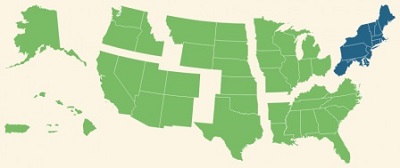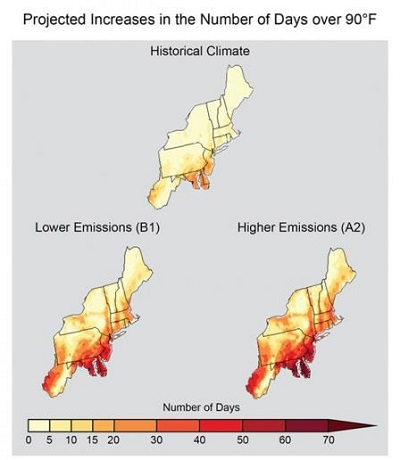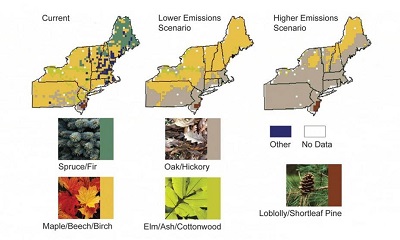|
|
| |
|
|
| |
|
|
|
|
| |
 Climate
Impacts in the Northeast Climate
Impacts in the Northeast
Overview
The Northeast is home to historic cities and large rural
areas that serve as important natural habitats and
agricultural lands. Climate varies widely across the region
and tends to be coldest in the north, at high elevations,
and away from the coast. |
 The
Northeastern climate is experiencing noticeable changes that
are expected to increase in the future. Between 1895 and
2011, temperatures rose by almost 2°F and projections
indicate warming of 4.5°F to 10°F by the 2080s. The
frequency, intensity, and length of heat waves is also
expected to increase. The total amount of precipitation and
the frequency of heavy precipitation events has also risen
in the region. Between 1958 and 2012, the Northeast saw more
than a 70% increase in the amount of rainfall measured
during heavy precipitation events, more than in any other
region in the United States. Projections indicate continuing
increases in precipitation, especially in winter and spring
and in northern parts of the region. However, the timing of
winter and spring precipitation could lead to drought
conditions in summer as warmer temperatures increase
evaporation and accelerate snow melt. The
Northeastern climate is experiencing noticeable changes that
are expected to increase in the future. Between 1895 and
2011, temperatures rose by almost 2°F and projections
indicate warming of 4.5°F to 10°F by the 2080s. The
frequency, intensity, and length of heat waves is also
expected to increase. The total amount of precipitation and
the frequency of heavy precipitation events has also risen
in the region. Between 1958 and 2012, the Northeast saw more
than a 70% increase in the amount of rainfall measured
during heavy precipitation events, more than in any other
region in the United States. Projections indicate continuing
increases in precipitation, especially in winter and spring
and in northern parts of the region. However, the timing of
winter and spring precipitation could lead to drought
conditions in summer as warmer temperatures increase
evaporation and accelerate snow melt.
Picture - The annual
number of days above 90°F is projected to increase,
especially for southern portions of the Northeast region.
This figure shows the average number of days with a maximum
temperature of at least 90°F historically (1971-2000) and
under two potential future scenarios (one with reduced
greenhouse gas emissions [B1], and one with increases in
emissions [A2]). Source: USGCRP (2014) |
|
Impacts on Human Health
Higher temperatures in the Northeast are likely to increase
heat-related deaths and decrease air quality, especially in
urban areas. People at greatest risk include young children,
the elderly, and those with pre-existing health conditions
like asthma. Those who live alone or in low income
communities are also at increased risk, particularly if
individuals do not have access to air conditioning or are in
poor health. Increased strains on cooling infrastructure and
greater energy demand could also affect access to air
conditioning during heatwaves. Residents in urban areas may
experience even warmer temperatures because of the heat
island effect, in which metropolitan areas are significantly
warmer due to dense populations and human activity.
Residents in rural areas are also at high risk because of
more buildings and homes without air conditioning.
Studies indicate that climate change is lengthening the
pollen season of common allergens such as ragweed,
particularly for northern portions of the U.S. Warmer and
wetter conditions may increase seasonal activity and the
extent of suitable habitat for ticks and mosquitoes,
elevating risks of human exposure to vector-borne diseases
like Lyme disease and West Nile Virus. More frequent extreme
precipitation events and flooding could increase the risk of
injury or death, exposure to waterborne illnesses, and
reduced access to clean water.
For more information about the impacts of climate change on
human health, please visit the Health page. |
|
|
 Impacts
on Precipitation and Sea Level Rise Impacts
on Precipitation and Sea Level Rise
Sea level rise, heavy precipitation, and storm surge are
expected to increase flooding and coastal erosion, and put
further strain on aging infrastructure in the Northeast.
Millions of Northeastern residents live near coastlines and
river floodplains, where they are potentially more
vulnerable to these climate-related impacts. During storm
events with heavy precipitation, combined sewer-stormwater
systems in this region can overload, resulting in wastewater
discharge into bodies of water used for recreation or
drinking water and creating health risks.
Picture - Observed
trends indicate an rise in sea level along Northeastern
shorelines. (Figure source: NOAA). In Philadelphia, PA, sea
level rose 1.2 feet between 1901 and 2012. Source: USGCRP
(2014)
In the Northeast, sea level has risen by approximately 1 ft
since 1900, which has caused more frequent flooding of
coastal areas. Globally, sea level is projected to rise by 1
to 4 ft by the end of this century. In the Northeast, even
higher sea level rise is possible, due to the combined
effects of warming waters and local land subsidence
(sinking). Sea level rise and coastal flooding are likely to
disrupt and damage important infrastructure, including
communication systems, energy production, transportation,
waste management, and access to clean water. These impacts
could have large economic implications across this region.
In Boston, Massachusetts, the increase in flooding caused by
sea level rise this century could cost up to $94 billion
from damage to buildings, loss of building contents, and
associated emergency activities, depending on the amount of
sea level rise and adaptation measures taken.
For more information on climate change impacts on coastal
resources, please visit the Coastal page. |
|
Impacts on Agriculture
Climate change is affecting agricultural production in the
Northeast. Heavy precipitation events can damage crops and
wetter springs may delay planting, resulting in later
harvest and reduced yields. Longer, drier summers may reduce
water availability and increase plant heat stress, also
reducing yields. Warmer spring temperatures may be followed
by cold snaps, causing frost damage, while warmer winters
and longer growing seasons may increase pressure from weeds
and pests. These challenges are likely to affect the types
of crops cultivated in the Northeast, as large portions of
the region may become unsuitable for growing fruits, like
apples and blueberries, and other crops, like grain and
soybean.
Dairy production is important to the Northeast's
agricultural economy and is expected to be negatively
affected by increasing temperatures. Warmer conditions cause
heat stress in farm animals, reducing milk yields and calf
birth rates. Projected warming temperatures could also
increase operations and production costs alongside
reductions in milk and meat production.
Fisheries are likely to be harmed by climate change. Many
commercially important species are projected to move
northward as the region's warming habitats become less
suitable. This shift in location is expected to cause local
declines in species including lobster and cod. New diseases
may also reduce the populations of fisheries. For example, a
bacterial shell disease that infects lobsters is currently
limited by low water temperatures in the northern portion of
the Northeast. Warming waters may allow this disease to move
northward causing reduced catch, similar to what has been
observed in southern parts of the region.
For more information about the impacts of climate change on
agriculture and food supplies, please visit the Agriculture
and Food Supply page. |
|
|
 Impacts
on Ecosystems Impacts
on Ecosystems
The Northeast is home to a diverse mixture of species and
ecosystems that are affected by climate change. Ranges of
certain tree species are moving northward and to higher
elevations where temperatures are cooler. The range of
economically important tree species, like sugar maple, is
expected to shrink within the U.S. as its preferred climate
shifts north into Canada. Warmer temperatures are also
increasing outbreaks of forests pests and pathogens,
including hemlock woolly adelgid. Growing deer populations
have been degrading forest understories, while invasive
plants like kudzu have been expanding their range and
contributing to a loss of biodiversity, function, and
resilience in some ecosystems.
Picture - Tree species
in the Northeast are shifting northward. The range of
spruce/fir, maple, and elm/ash/cottonwood forests are
shrinking and being replaced by oak/hickory forest in most
of the region, and by loblolly/shortleaf pine forest in the
southernmost areas. Source: USGCRP (2009)
Temperature changes also influence the timing of important
ecological events, causing birds to migrate sooner and
plants to bloom and leaf earlier. Climate change and sea
level rise are expected to harm coastal ecosystems, causing
declines in water quality, increasing harmful algal blooms,
and shrinking marsh habitat.
For more information about the impacts of climate change on
ecosystems, please visit the Ecosystems and Forests page. |
|
|
Impacts on Winter Recreation
Winter recreational snow and ice activities generate about
$7.6 billion for the Northeast economy annually. These
activities include snow sports (skiing, snowmobiling,
snowshoeing, dog sledding) and ice-based activities (ice
fishing and skating). Projected increases in temperature
could reduce snow cover and shorten winter snow seasons,
limiting and altering these activities.
In order for ski resorts to remain viable in the Northeast,
the average length of the ski season should be at least 100
days, nights must be cold enough to allow for artificial
snowmaking, and there must usually be snow during winter
holidays when winter tourism is high. Projections indicate
that marginal ski resorts in the region will likely close
and most resorts will be vulnerable by the end of the
century because temperatures will become too warm to meet
these criteria. Resorts are likely to require more
artificial snowmaking to produce snowpack, employing
additional water and energy and increasing costs to the
resorts. |
|
|
EPA Page |
|
This is the
EPA page for this topic. To see if the Trump
administration has changed the EPA page, simply click the
link and compare the information with this page. If you
notice changes were made to the EPA page, please post a
comment. Thanks. |
|
|
Key Points
The Northeast is experiencing warming temperatures and a
large increase in the amount of rainfall measured during
heavy precipitation events.
More frequent heat waves in the Northeast are expected to
increasingly threaten human health through more heat stress
and air pollution.
Sea level rise and more frequent heavy rains are expected to
increase flooding and storm surge, threatening
infrastructure.
As temperatures rise, agriculture will likely face reduced
yields, potentially damaging livelihoods and the regional
economy. |
|
|
|
|
|
|
|
|
|
|
|
|
Additional Climate Change Information |
Climate Change and Carbon Dioxide
(Beginner - Listening,
reading)
A video lesson to
help with your understanding of climate change
and carbon dioxide.
The English is
spoken at 75% of normal speed.
Great English listening and reading practice. |
Carbon Dioxide and Climate Change
(Beginner - Listening,
reading)
A video lesson to
help with your understanding of carbon dioxide
and climate change.
The English is
spoken at 75% of normal speed.
Great English listening and reading practice. |
Environmental Group Warns Earth's Health at Risk
(Beginner - Listening,
reading)
A video lesson to
help with your understanding of climate change.
The English is
spoken at 75% of normal speed.
Great English listening and reading practice.
A report by the World Wildlife Fund looked at thousands of animal populations
and found they have dropped significantly in 40 years. |
Sea Levels Rising at Fastest Rate in 3,000 years
(Beginner - Listening,
reading)
A video lesson to
help with your understanding of climate change.
The English is
spoken at 75% of normal speed.
Great English listening and reading practice.
A group of scientists say sea levels are rising at record rates. Another group
found that January temperatures in the Arctic reached a record high. |
Capturing CO2 Gas Is Not Easy
(Beginner - Listening,
reading)
A video lesson to
help with your understanding of climate change.
The English is
spoken at 75% of normal speed.
Great English listening and reading practice.
Most scientists agree that carbon-dioxide gas is partly to blame for climate
change: rising global temperatures. But capturing the CO2 gas released by power
stations is costly and difficult. |
Growth, Climate Change Threaten African Plants and
Animals
(Beginner - Listening,
reading)
A video lesson to
help with your understanding of climate change.
The English is
spoken at 75% of normal speed.
Great English listening and reading practice.
Researchers believe Africa may lose as much as 30 percent of its animal and
plant species by the end of this century. |
|
|
|
|
Search Fun Easy English |
|
|
|
|
|
|
|
|
|
|
|
|
|
|
|
About
Contact
Copyright
Resources
Site Map |